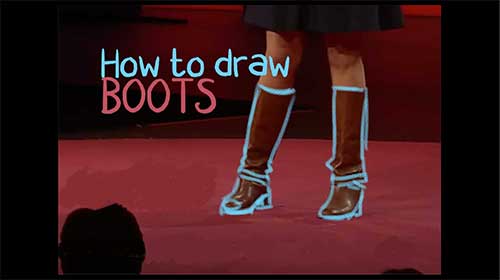How to Draw Boots {For Cartooning}

Yvonne sat with her pencil in hand frowning at the page.
“Winter again,” she thought. “That means my cartoon character needs to wear boots. Ugh!”
If, like Yvonne, the thought of drawing footwear makes your heart sink into your boots, take a deep breath and relax.
We’ll look at a real life example (ladies’ boots) and focus on just three principles to create the greatest improvement in how you draw footwear for all your cartoon characters.
The three ‘how to draw boots 101’ principles are:
-
- choose the best angles
-
- focus on key features
-
- select the right optional extras
Choosing the best angles – how to draw boots
It’s very common to default to drawing boots and shoes from a face-on position. The problem is that this is a very dull angle that sucks the movement and detail out of your character’s footwear. The lines are mostly straight and if you don’t include a lot of detail (which may not be present in the footwear of choice) it’s very difficult to portray a decent shoe or boot.
As drawing footwear involves two feet, it’s relatively easy to find a better angle than a face on view — having one foot at 45 degrees to the viewer happens very easily. If one foot is at an angle to the viewer, it makes your task of how to draw boots much simpler immediately because the details of that boot are easily identifiable.
Focusing on key features
What are the key features when it comes to drawing boots? With so many to choose from when we look at our particular example of highly polished ladies boots, which are the key features which apply to all footwear?
The heel and sole are the most important part of the footwear when you are drawing, because they define the foot in relation to the floor line. The heel and sole is what grounds the foot, or gives it attitude.
Once you have the heel and sole in place, you can go on to define the toe of the shoe or boot and how it fits around the ankle. That brings us to the optional extras.
How do you select optional extras to include?
Of course they will vary depending on what footwear you are drawing, but essentially you want the extra details to reinforce how the toe and top of the shoe or boot looks, as well as how it fits around or near the ankle.
In this specific example, wrinkles, buckles, and reflections would be the option we use to portray the boots in different poses. In other footwear it may be how they lace up, whether they have patterns or decorative stitching which sets them apart.
Overall, limit your detail to the minimum to convey how the boots or shoes fit in with your character’s personality, otherwise you can get bogged down and everything becomes time consuming.
The real-life mobility of ankle and knee joints may surprise you!
That’s why I mention in the video the value of using a reference — sometimes copying a real pose is the only way to get around the ‘stiffly wooden’ leg and foot poses that our minds jump to up when we try to draw on autopilot. Look at the angle of the calves in relation to the sole of the foot and focus on getting it as accurate as possible to have the liveliest pose wherever possible.
Why don’t I use cartoon boots as examples?
We haven’t started out looking at actual cartoon boots because cartoonists naturally apply their creative license to their work and that can be confusing when you’re still trying to get to grips with principles. Once you know the principles, you can choose to reinvent them for your own creative and comedic purposes but at the outset, understanding what makes boots look “right” is more important.
Thinking about joining my guided online cartooning course that starts every August?
Here’s what 2017 participant Ann van Eron from the US had to say:
I learned how to see in a new way and trusted the process. I had never drawn and had never had an art class (except in high school and I was not confident.) We started simply by drawing circles and graduated from there to tracing and sketching.
I still have a lot to learn but the course works for different levels of skill. It is a fun experience.
I recommend this to anyone who would like to be drawing cartoons for their website or blog or who want to explore cartooning. The course is well organized and if you are consistent and commit to sketching each day, you will be surprised at your progress.
One of my sisters asks me to send her my cartoons each week and says she can’t wait to see them. My family members and friends tell me they enjoy my cartoons. They are as surprised as I am. Clients also say they appreciate them. I can’t believe I am sharing them.

